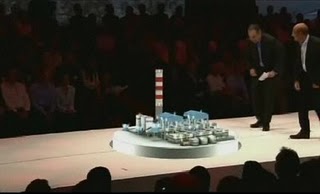Copper gear 3D printed with metal filament [Source: The Virtual Foundry]![Copper gear 3D printed with metal filament [Source: The Virtual Foundry]](https://fabbaloo.com/wp-content/uploads/2020/05/image-asset_img_5eb0653c3c0b6.jpg)
I’ve been following the development of metal 3D printer filaments for quite a while now, and found an interesting service that provides many different filament options.
Metal Filaments?
The first extrusion-based 3D printers used thermoplastic materials, and the first material commonly used was ABS. ABS is a relatively terrible material to 3D print with, as it tends to warp, poorly adhere to print beds and off-gasses noxious odors. The prints were OK, if you could get them.
The reason for use of ABS at the time was in those days there were no suppliers of 3D printer filament, aside from Stratasys for their own equipment. 3D printer operators thus had to make do by repurposing materials from existing suppliers, such as welding wire. That product was easily found made from ABS, thus the initial standard use pattern.
But since those days things have changed immensely.
Dedicated 3D Printer Material Suppliers
As the popularity of 3D printers requiring third-party materials increased, a number of suppliers dedicated to producing 3D printer filament emerged. Initially the battle between them was over pricing, but that eventually died out as the cheapest filaments turned out to be nearly impossible to print due to poor quality.
Then the competitive field moved on to the nature of the materials themselves. New materials beyond PLA and ABS were slowly added, and eventually someone came up with the idea of hybrid materials involving metal powder.
Early Metal 3D Printer Filaments
A hybrid material is a standard 3D printing material such as PLA mixed with a fine powder of an alternative material. The polymer provides the printing capability, while the additive provides some additional properties.
Many different additives were attempted, including some ridiculous options like coffee, bamboo and even a foul-smelling algae 3D printer filament. Eventually metal powders were added to filaments.
These early “metal” filaments would be comprised of a 20-60% metal powder. They were often difficult to 3D print as the powder made the filament quite brittle, and the hardness of the metals tended to quickly erode the soft brass nozzles mounted on 3D printers of the day.
Prints made from these early metal filaments were definitely different. They were somewhat harder and could even be polished. But in the end they were not particularly popular as the materials were insufficient for engineering use. While you can still purchase them in certain places, some have been discontinued due to lack of interest.
True Metal Filaments
In more recent times proper metal filaments have emerged. These are carefully designed mixes of metal powders and polymers to ensure printability and the ability to form pure metal objects. Often the metal content is quite high, even as much as 80+% of the filament by weight.
It works by using a multi-step process. First the target object is 3D printed using the special metal filament. Then the print is treated to “burn out” the polymer, which served as a binder to hold the metal particles together. Then the object is sintered in a high-temperature furnace to fuse the metal particles together into a pure metal solid object. In the process the object tends to shrink substantially, sometimes as much as 20%, and so operators have to oversize the 3D print to compensate.
There are several vendors selling one or two metal filaments of this type, but they are not particularly popular. I think there are two reasons for this. First, these filaments tend to be quite expensive, and secondly, there are few people that happen to have a sintering furnace handy. Workshops that do likely already have metalworking capability and may not be interested in 3D printed metal objects.
Metal 3D Printer Filament Choice
![Metal chain matrix 3D printed with metal filament [Source: The Virtual Foundry]](https://fabbaloo.com/wp-content/uploads/2020/05/image-asset_img_5eb0653c90cb3.jpg)
Metal chain matrix 3D printed with metal filament [Source: The Virtual Foundry]
Due to the constrained interest I thought there would be a smaller choice of materials in the market. But I then encountered The Virtual Foundry, a 3D printer materials company that seems to be dedicated to producing a wide variety of metal filaments.
Their major product line is called “Filamet”, a play on “filament” and “metal”, and they offer a series of metal options, all of which are lead-free:
-
Aluminum (65%) US$126/kg
-
Bronze (87%) US$182/kg
-
Copper (90%) US$121/kg
-
High carbon iron (80%) US$144/kg
-
Inconel 718-34 (86%) US$410/kg
-
17-4 stainless steel (85%) US$153/kg
-
316L stainless steel (85%) US$273/kg
-
Titanium (80%) US$704/kg
-
Tungsten (92-95%) US$559/kg
Most of these filaments are available from The Virtual Foundry in 1.75mm or 2.85mm format on either 0.5 or 1kg spools. Some materials are available in pellet form as well.
All of these filaments are easy to 3D print on most machines, although it’s recommended to use a 0.6mm nozzle of high hardness. For bed adhesion it seems you only need blue painter’s tape. Nozzle and print surface temperatures are easily within the range of most devices. They do recommend the use of a filament warming device to ensure the filament prints more easily.
One interesting point is that The Virtual Foundry says their tungsten material can be used to 3D print radiation-proof objects, something that cannot be easily done with other materials.
They even offer to develop custom metal filaments for those who require different metals or even metal alloys. For those requiring a sintering furnace, they also offer those, too, although they are pricey for casual use at US$30K. For more casual use they direct you to a number of sintering services that can post-process metal prints.
While 3D printed metal filament is still a bit rare, it’s good to see there are widening choices in material types.

